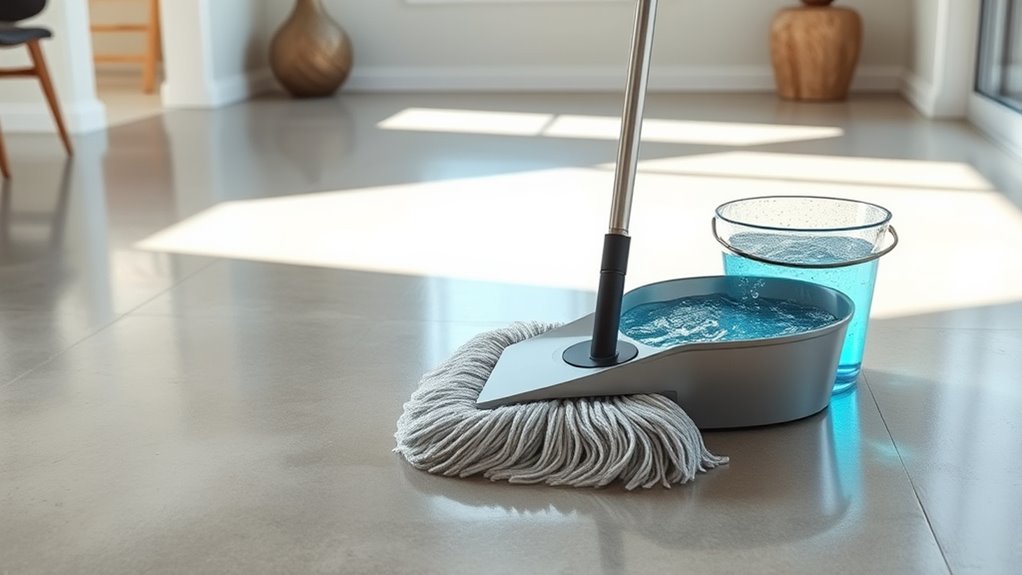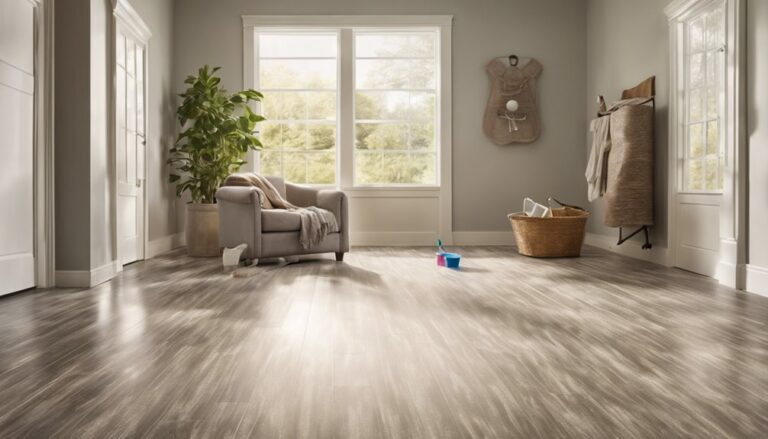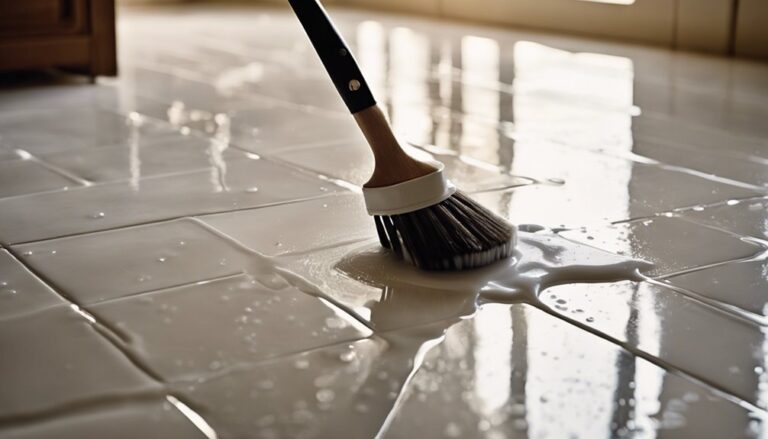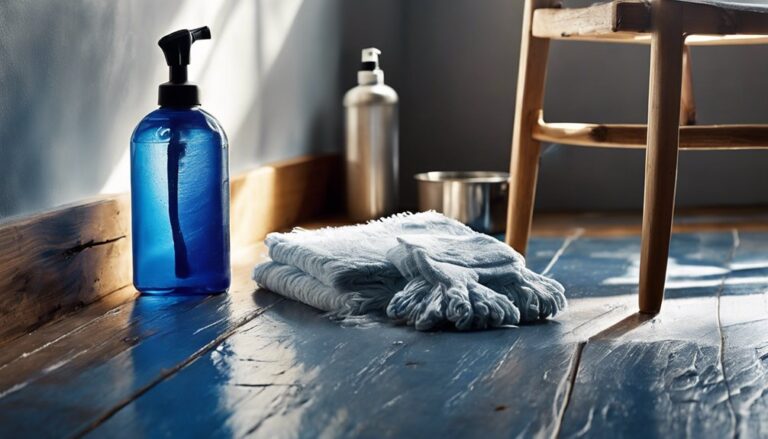To clean concrete flooring effectively, first identify its type—polished, sealed, or bare—to choose the right method. Start by sweeping with a soft broom or microfiber mop to remove debris. Use a pH-neutral cleaner with mild detergents for damp mopping. For stains, act quickly with appropriate solvents and blot spills immediately. Avoid harsh chemicals or acidic cleaners that can damage the surface. Regular maintenance and periodic resealing will keep it durable and attractive. You’ll find additional tips to optimize your concrete care below.
Assessing the Type of Concrete Floor
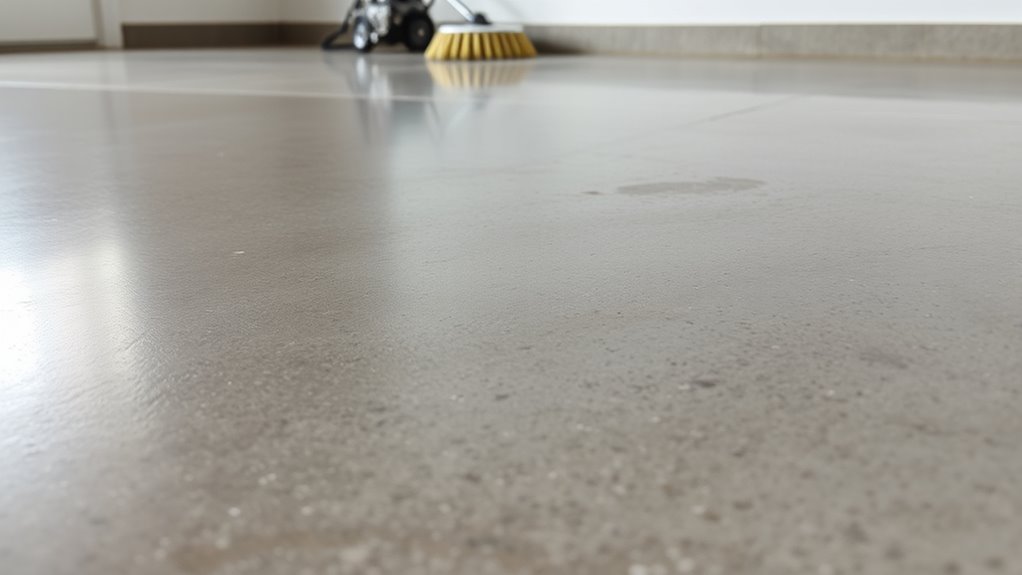
Before you begin cleaning, it’s important to identify the specific type of concrete floor you have, as this determines the appropriate cleaning methods and products. Concrete floors come with various types of finishes—polished, sealed, stained, or bare—that influence their resistance to stains and abrasions. Understanding the concrete durability is vital; polished concrete is more durable and less porous, allowing for easier cleaning with mild detergents, while sealed floors require pH-neutral cleaners to maintain the protective layer. Stained or decorative concrete needs gentle care to preserve its appearance. Assess your floor by examining its texture, sheen, and any surface treatments. This precise evaluation guarantees you select cleaning techniques that respect the floor’s integrity and maximize your freedom to maintain it effectively without causing damage.
Gathering Essential Cleaning Supplies
Once you’ve identified your concrete floor type and its specific care needs, the next step is to assemble the right cleaning supplies tailored to those requirements. Start with basic cleaning tools: a stiff-bristle broom or microfiber mop for dry debris removal, and a bucket for mixing cleaning solutions. Choose a pH-neutral cleaner to avoid damaging the concrete’s surface. For eco friendly options, consider biodegradable soaps or vinegar-based solutions that maintain effectiveness without harsh chemicals. Avoid acidic or abrasive cleaners that can erode sealants or polish. A scrub brush with synthetic bristles is ideal for stubborn stains. Gloves and protective eyewear guarantee safety during cleaning. By selecting appropriate, efficient tools and eco friendly products, you maintain your floor’s integrity while supporting environmental responsibility and retaining your freedom to manage maintenance confidently.
Sweeping and Dusting the Surface
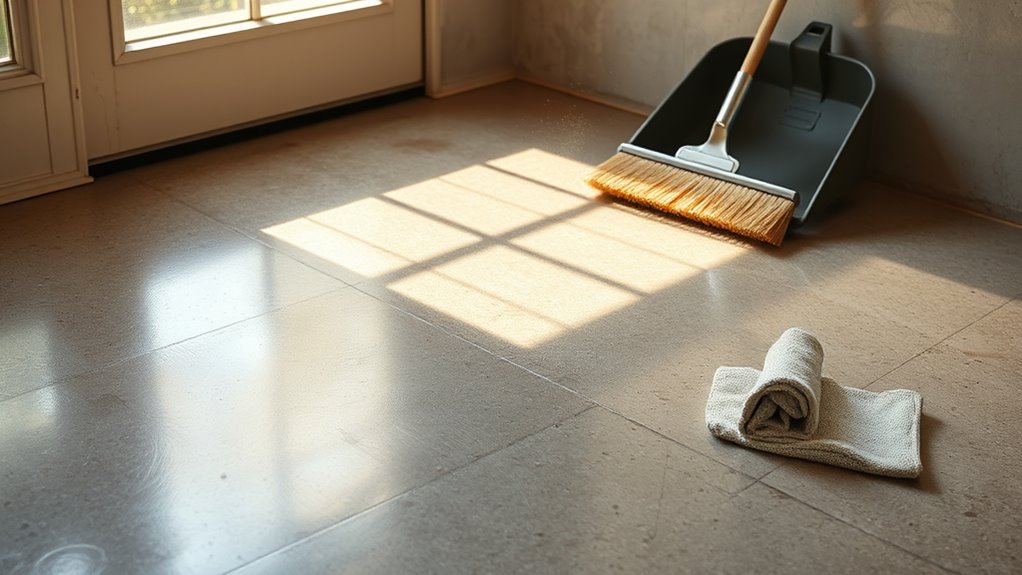
Although it may seem straightforward, sweeping and dusting concrete floors require careful attention to detail to prevent surface abrasion and maintain cleanliness. You’ll want to prioritize dust control to protect the surface and extend its lifespan. Use a soft-bristle broom or microfiber dust mop, avoiding stiff bristles that can scratch the concrete. Sweep in overlapping strokes, collecting dust particles efficiently without dispersing them into the air.
| Tool Type | Uso consigliato | Surface Protection Level |
|---|---|---|
| Soft-bristle Broom | Daily dry sweeping | Alto |
| Mocio in microfibra | Fine dust removal | Molto alto |
| Dustpan & Brush | Collect debris | Moderare |
| Vacuum (HEPA) | Post-sweep cleanup | Alto |
| Mocio umido | Final dust control pass | Molto alto |
This method guarantees thorough dust control, maintaining your concrete floor’s integrity.
Removing Stains and Spills
Dealing with stains and spills on concrete pavimentazione requires prompt and specific actions to prevent permanent discoloration or damage. Identifying stain types—oil, rust, paint, or organic—is essential for effective removal. Quick spill prevention reduces penetration depth, making cleanup easier.
To tackle stains and spills effectively:
- Blot spills immediately with an absorbent cloth to limit spread.
- Use appropriate solvents based on stain type; avoid harsh chemicals.
- Apply poultices for stubborn stains, allowing them to draw out contaminants.
- Test cleaning agents on a small, inconspicuous area first.
- Rinse thoroughly and dry to prevent residue or further staining.
Deep Cleaning With Mild Detergents

When you want to maintain the integrity of your concrete flooring without causing damage, deep cleaning with mild detergents is the best approach. Start by selecting safe detergents specifically formulated for concrete surfaces; avoid harsh chemicals that can erode or discolor the material. Dilute the detergent according to the manufacturer’s instructions to guarantee ideal effectiveness. Apply the solution evenly across the floor, then use gentle scrubbing motions with a soft-bristle brush or mop to lift embedded dirt and grime without abrading the surface. Rinse thoroughly with clean water to remove all detergent residues, preventing any buildup that could attract dirt. This method preserves the concrete’s durability and appearance while giving you freedom from aggressive treatments that risk long-term harm.
Using a Pressure Washer Safely
When using a pressure washer on concrete flooring, set the pressure between 1,500 and 3,000 PSI to avoid surface damage. Always wear protective gear, including gloves, safety goggles, and sturdy footwear, to prevent injury. Proper settings and safety equipment guarantee effective cleaning without compromising your safety or the concrete’s integrity.
Choosing Proper Pressure Settings
Although pressure washers can effectively clean concrete flooring, selecting the correct pressure setting is essential to avoid surface damage or insufficient cleaning. You need to take into account the concrete types you’re working with since older or porous concrete requires lower pressure to prevent erosion. Conversely, newer, dense concrete tolerates higher pressure for deeper cleaning. Adjusting pressure settings precisely guarantees ideal results without compromising the surface integrity.
Keep these points in mind:
- Use 1500-2500 PSI for most concrete types.
- Reduce pressure below 1500 PSI for delicate or stained concrete.
- Increase pressure cautiously for heavily soiled, durable concrete.
- Test pressure on a small area before full cleaning.
- Maintain consistent distance to avoid uneven cleaning or damage.
Choosing proper pressure settings grants you the freedom to clean safely and effectively.
Protective Gear Importance
Since pressure washers operate at high force and can eject debris, wearing the appropriate protective gear is essential to prevent injuries and guarantee safe handling. Prioritize gear selection by choosing impact-resistant goggles to shield your eyes from flying particles. Use gloves with strong grip and chemical resistance to protect your hands from high-pressure water and cleaning agents. A durable, waterproof apron and non-slip boots will shield your body and enhance stability on wet surfaces. Always implement safety precautions by inspecting your gear for damage before use and ensuring all equipment fits properly to maintain freedom of movement. Remember, the right protective gear not only minimizes injury risks but also empowers you to operate the pressure washer confidently and efficiently. Safety and freedom go hand in hand when cleaning concrete flooring.
Drying and Preventing Water Spots
As moisture evaporates from concrete flooring, it can leave behind mineral deposits that cause unsightly water spots. To guarantee effective drying and water spot prevention, you need to implement precise drying techniques immediately after cleaning.
Consider these practical steps:
- Use microfiber mops or squeegees to remove excess water quickly.
- Employ fans or portable blowers to accelerate evaporation.
- Avoid letting water pool in crevices or uneven areas.
- Apply a protective sealant to reduce water absorption and mineral buildup.
- Wipe down surfaces with a soft cloth to catch residual moisture.
Tips for Regular Maintenance and Care
You should sweep your concrete floors daily to remove abrasive debris that can cause surface damage over time. Implement preventive measures like using mats at entry points and promptly cleaning spills to avoid stains. Consistent care will extend the flooring’s durability and maintain its appearance.
Daily Sweeping Routine
Maintaining a daily sweeping routine is essential for preserving the integrity of your concrete flooring. Proper sweeping techniques prevent dust accumulation, which can degrade the surface over time and reduce slip resistance. You’ll want to use a broom with stiff, synthetic bristles to effectively capture fine particles without scratching the concrete. Consistency in your routine guarantees debris doesn’t embed into the porous material, preserving its longevity. Here are key points to follow:
- Sweep in one direction to avoid redistributing dust
- Focus on high-traffic zones where dirt accumulates faster
- Use dustpans or a vacuum designed for hard floors to collect debris
- Avoid using water during daily sweeping to prevent slip hazards
- Inspect the floor regularly for stubborn dirt spots needing extra attention
This approach keeps your concrete floor clean and durable, letting you enjoy unrestricted freedom in your space.
Preventive Stain Measures
Although concrete is durable, it’s susceptible to stains that can compromise its appearance and longevity if not properly protected. To guarantee effective stain prevention, you should apply a high-quality protective sealant tailored to your concrete’s specific porosity and environment. Sealants create a barrier that repels liquids, reducing the risk of absorption and subsequent staining. Regularly inspect the flooring for wear and reapply sealants as recommended by the manufacturer, typically every 1-3 years. Additionally, immediately clean spills with appropriate cleaners to prevent stain setting. Incorporating mats or rugs in high-traffic or spill-prone areas further enhances protection. By combining these preventive stain measures with routine maintenance, you maintain your concrete’s integrity and aesthetic, granting you lasting freedom from costly repairs and stubborn stains.

